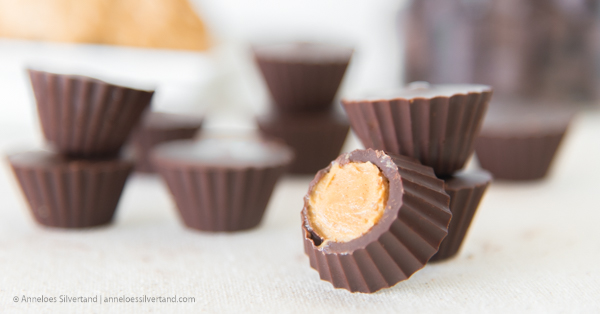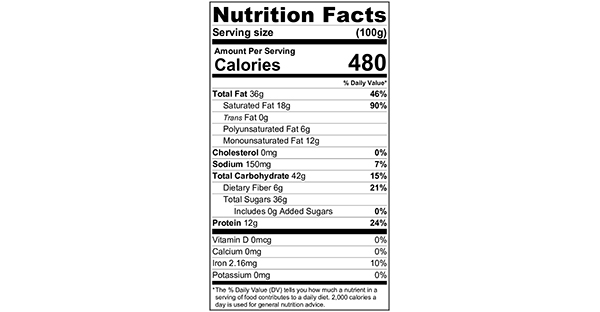Step right up, step right up! Calling all the chocolate and peanut butter lovers out there! Come and try this Dark Chocolate Peanut Butter Cups recipe! Well, you don’t actually have to come to visit me, but you get where I am going with this. If you are feeling very adventurous, you can even make your very own peanut butter! Check out the link to that recipe below, in the ingredient list.

If you have any dietary restrictions, always check the labels on the products you are using to make this recipe with. They will tell you if, for instance, your ingredient might contain traces of nuts, your products are made with dairy or if there is a chance the ingredients have come into contact with gluten-containing food or equipment.
Would you like to know more about what to look for when you are buying your products while you have dietary restrictions or preferences? Are you preparing food for someone who does? Check out my articles on [Food and Health] and learn more!
Do you like the Dark Chocolate Peanut Butter Cups recipe? Please share it or leave a comment and follow Truthful Food on social media so that you won’t miss out on anything new and delicious!
Ingredients
- 100 g Dark Chocolate - [See good to know section.]
- 50 g Peanut Butter - [Check out my recipe!]
Other thing you need
- Food Scale
- Silicone Mold - [See good to know section.]
- Hot Water
- 2 Bowl
- Spoon
- Piping Bag
- Piping Tip
- Stove
Instructions
- Weigh your ingredients.
- Melt your chocolate. How? [Check out my article and video!][See good to know section.]
- Pour a thin layer of chocolate everywhere in the mould. It should be about 2-3 millimetres thick.
- Put the mould in the refirgerator and let the chocolate set for about 5 minutes.
- Put a tip in your piping bag and fill the bag with peanut butter. [See good to know section.]
- Take the mould out of your fridge and pipe the peanut butter (about 5 grams per chocolate) onto the hardened chocolate. Make sure the peanut butter does not touch any of the sides of the mould!
- Pour some chocolate around the peanut butter and on top of it. Make sure all the peanut butter is covered. Repeat this step for all the chocolates.
- If necessary, gently(!) shake the mould while the chocolate is still soft. This will let the chocolate settle around the peanut butter and it will allow air bubbles to escape.
- Put the chocolates in the refrigerator for about 45 minutes.
- Take your Dark Chocolate Peanut Butter Cups from the refrigerator and enjoy!
Good to know
- Storing: Make sure to store your chocolates in an airtight container in your refrigerator if you are not eating all of them right away.
- Shelf Life: The chocolates will stay good for several months if stored correctly.
- Type of chocolate: The better the chocolate is you use, the better your creations will taste.
- Gluten-free: Make sure the ingredients are gluten-free.
- Vegan: Use vegan chocolate.
- Organic: Only use organic ingredients.
- Tip: Make sure that your piping tip is big enough to let all the peanut butter flow smoothly. This is especially important if you are using chunky peanut butter.
- Tempering chocolate: If you want your chocolate to be shiny, make sure you temper it, before you use it.
- Chocolate mould: In case you were wondering, this is the mould I use to make these chocolates. [this is the mould I used to make these chocolates]
Nutritional Information per Portion
Know What You Eat
Both when buying food or when making your own, it is important to inform yourself about the nutritional value. Have a look at the nutrition label, learn about your serving size and what nutrients this product will bring to the table.
If you want to compare different products and their values, it is easier to look at a label where the values are given per 100 grams. This way you get a better understanding of the categories certain products belong to when it comes to nutritional values. Is this a product with a high sugar content? Does it contain a lot of fibre? How does this product measure up if I am looking to stick to a low-sodium diet?

Keep in mind that if you are looking to eat healthily, you should not just avoid eating fat and/or sugar. We need both in our daily diet. Make sure however to be aware of where you get your lipids and sugars from. As a rule of thumb, you could say; variation is very important in your diet and in general, the closer your food is to come straight from the source, the better.
If you want to read more about healthy food choices, check out my article [Healthy Food Choices]. Truthful Food also has a continuously growing article category solely focusing on specific ingredients and nutrients for everyone who wants to take a closer look at what you can find in your food.
*All given nutritional information is an indication. Due to differences in how ingredients are produced, where they are purchased and how the recipe is prepared, nutritional values may vary.
Leave a Reply